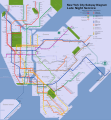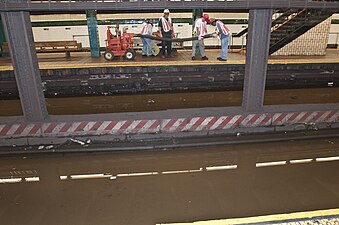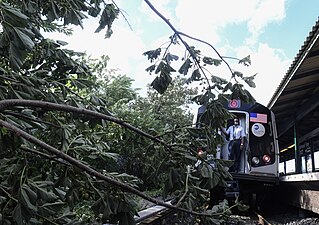New York City Subway

| New York City Subway | |||
|---|---|---|---|
 | |||
 Top: A 1 train made up of ten R62A cars enters the 207th Street station. Bottom: An E train made up of ten R160A cars enters the 42nd Street–Port Authority Bus Terminal station. | |||
| Overview | |||
| Owner | City of New York | ||
| Area served | The Bronx, Brooklyn, Manhattan, and Queens | ||
| Locale | New York City | ||
| Transit type | Rapid transit | ||
| Number of lines | 36 lines[note 1] 28 services (1 planned)[note 2] | ||
| Number of stations | 472[1] (MTA total count)[note 3][note 4] 423 unique stations[note 4][1] (when compared to international standards) 14 planned[note 3] | ||
| Annual ridership | 2,027,286,000[6]: 2 [note 5] (2023) | ||
| Website | new | ||
| Operation | |||
| Began operation | October 27, 1904 (Original subway) July 3, 1868[7] (first railroad operation)[note 6] | ||
| Operator(s) | New York City Transit Authority (NYCTA) | ||
| Number of vehicles | 6,787[8] | ||
| Headway | Peak hours: 2–10 minutes[9] Off-peak: 8–16 minutes[9] | ||
| Technical | |||
| System length | 248 mi (399 km)[10] (route length) 665 mi (1,070 km)[10] (track length, revenue) 850 mi (1,370 km)[11] (track length, total) | ||
| Track gauge | 4 ft 8+1⁄2 in (1,435 mm) standard gauge[11] | ||
| Electrification | Third rail, 600–650 V DC (625 V nominal)[11][12] | ||
| Average speed | 17.4 mph (28.0 km/h)[13] | ||
| Top speed | 55 mph (89 km/h)[13] | ||
| |||
| Part of a series of articles on |
The New York City Subway is a rapid transit system in New York City serving the boroughs of Manhattan, Brooklyn, Queens, and the Bronx. It is owned by the government of New York City and leased to the New York City Transit Authority,[14] an affiliate agency of the state-run Metropolitan Transportation Authority (MTA).[15] Opened on October 27, 1904, the New York City Subway is one of the world's oldest public transit systems, one of the most-used, and the one with the most stations,[16] with 472 stations in operation[17] (423, if stations connected by transfers are counted as single stations).[1]
The system has operated 24/7 service every day of the year throughout most of its history, barring emergencies and disasters. By annual ridership, the New York City Subway is the busiest rapid transit system in both the Western Hemisphere and the Western world, as well as the eleventh-busiest rapid transit rail system in the world.[18] The subway carried 2,027,286,000 unlinked, non-unique riders in 2023.[6]: 2 [note 5] Daily ridership has been calculated since 1985; the record, over 6.2 million, was set on October 29, 2015.[20]
The system is also one of the world's longest. Overall, the system contains 248 miles (399 km) of routes,[10] translating into 665 miles (1,070 km) of revenue track[10] and a total of 850 miles (1,370 km) including non-revenue trackage.[11] Of the system's 28 routes or "services" (which usually share track or "lines" with other services), 25 pass through Manhattan, the exceptions being the G train, the Franklin Avenue Shuttle, and the Rockaway Park Shuttle. Large portions of the subway outside Manhattan are elevated, on embankments, or in open cuts, and a few stretches of track run at ground level; 40% of track is above ground.[21] Many lines and stations have both express and local services. These lines have three or four tracks. Normally, the outer two are used by local trains, while the inner one or two are used by express trains.[11]
As of 2018[update], the New York City Subway's budgetary burden for expenditures was $8.7 billion, supported by collection of fares, bridge tolls, and earmarked regional taxes and fees, as well as direct funding from state and local governments.[22]
History
[edit]
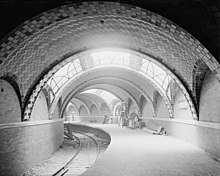
Alfred Ely Beach built the first demonstration for an underground transit system in New York City in 1869 and opened it in February 1870.[23][24] His Beach Pneumatic Transit only extended 312 feet (95 m) under Broadway in Lower Manhattan operating from Warren Street to Murray Street[23] and exhibited his idea for an atmospheric railway as a subway. The tunnel was never extended for political and financial reasons.[25] Today, no part of this line remains as the tunnel was completely within the limits of the present-day City Hall station under Broadway.[26][27][28][29] The Great Blizzard of 1888 helped demonstrate the benefits of an underground transportation system.[30] A plan for the construction of the subway was approved in 1894, and construction began in 1900.[31] Even though the underground portions of the subway had yet to be built, several above-ground segments of the modern-day New York City Subway system were already in service by then. The oldest structure still in use opened in 1885 as part of the BMT Lexington Avenue Line in Brooklyn[32][33][34][35][36] and is now part of the BMT Jamaica Line.[37] The oldest right-of-way, which is part of the BMT West End Line near Coney Island Creek, was in use in 1864 as a steam railroad called the Brooklyn, Bath and Coney Island Rail Road.[38][39][40]
The first underground line of the subway opened on October 27, 1904, almost 36 years after the opening of the first elevated line in New York City (which became the IRT Ninth Avenue Line).[41][42] The 9.1-mile (14.6 km) subway line, then called the "Manhattan Main Line", ran from City Hall station northward under Lafayette Street (then named Elm Street) and Park Avenue (then named Fourth Avenue) before turning westward at 42nd Street. It then curved northward again at Times Square, continuing under Broadway before terminating at 145th Street station in Harlem.[43] Its operation was leased to the Interborough Rapid Transit Company (IRT), and over 150,000 passengers[44] paid the 5-cent fare ($2 in 2023 dollars [45]) to ride it on the first day of operation.[46]
By the late 1900s and early 1910s, the lines had been consolidated into two privately owned systems, the IRT and the Brooklyn Rapid Transit Company (BRT, later Brooklyn–Manhattan Transit Corporation, BMT). The city built most of the lines and leased them to the companies.[47] The first line of the city-owned and operated Independent Subway System (IND) opened in 1932.[48] This system was intended to compete with the private systems and allow some of the elevated railways to be torn down but stayed within the core of the city due to its small startup capital.[14] This required it to be run 'at cost', necessitating fares up to double the five-cent fare of the time, or 10¢ ($3 in 2023 dollars [45]).[49]
In 1940, the city bought the two private systems. Some elevated lines ceased service immediately while others closed soon after.[50] Integration was slow, but several connections were built between the IND and BMT.[51][52][53] These now operate as one division, called the B Division. Since the former IRT tunnels are narrower, have sharper curves, and shorter station platforms, they cannot accommodate B Division cars, and the former IRT remains its own division, the A Division.[54] Many passenger transfers between stations of all three former companies have been created, allowing the entire network to be treated as a single unit.[55]
During the late 1940s, the system recorded high ridership, and on December 23, 1946, the system-wide record of 8,872,249 fares was set.[56]: 73
The New York City Transit Authority (NYCTA), a public authority presided by New York City, was created in 1953 to take over subway, bus, and streetcar operations from the city, and placed under control of the state-level Metropolitan Transportation Authority in 1968.[55][57]

Organized in 1934 by transit workers of the BRT, IRT, and IND,[58] the Transport Workers Union of America Local 100 remains the largest and most influential local of the labor unions.[59] Since the union's founding, there have been three union strikes over contract disputes with the MTA:[60] 12 days in 1966,[61] 11 days in 1980,[62] and three days in 2005.[63][64]
By the 1970s and 1980s, the New York City Subway was at an all-time low.[65][66] Ridership had dropped to 1910s levels, and graffiti and crime were rampant. Maintenance was poor, and delays and track problems were common. Still, the NYCTA managed to open six new subway stations in the 1980s,[67][68] make the current fleet of subway cars graffiti-free, as well as order 1,775 new subway cars.[69] By the early 1990s, conditions had improved significantly, although maintenance backlogs accumulated during those 20 years are still being fixed today.[66]

Entering the 21st century, progress continued despite several disasters. The September 11 attacks resulted in service disruptions on lines running through Lower Manhattan, particularly the IRT Broadway–Seventh Avenue Line, which ran directly underneath the World Trade Center.[70] Sections of the tunnel, as well as the Cortlandt Street station, which was directly underneath the Twin Towers, were severely damaged. Rebuilding required the suspension of service on that line south of Chambers Street. Ten other nearby stations were closed for cleanup. By March 2002, seven of those stations had reopened. Except for Cortlandt Street, the rest reopened in September 2002, along with service south of Chambers Street.[71][72][73] Cortlandt Street reopened in September 2018.[74]
In October 2012, Hurricane Sandy flooded several underwater tunnels and other facilities near New York Harbor, as well as trackage over Jamaica Bay. The immediate damage was fixed within six months, but long-term resiliency and rehabilitation projects continued for several years. The recovery projects after the hurricane included the restoration of the new South Ferry station from 2012 to 2017; the full closure of the Montague Street Tunnel from 2013 to 2014; and the partial 14th Street Tunnel shutdown from 2019 to 2020.[75] Annual ridership on the New York City Subway system, which totaled nearly 1.7 billion in 2019, declined dramatically during the COVID-19 pandemic and did not surpass one billion again until 2022.[76]
Construction methods
[edit]
When the IRT subway debuted in 1904,[41] the typical tunnel construction method was cut-and-cover.[77] The street was torn up to dig the tunnel below before being rebuilt from above.[77] Traffic on the street above would be interrupted due to the digging up of the street.[78] Temporary steel and wooden bridges carried surface traffic above the construction.[79]
Contractors in this type of construction faced many obstacles, both natural and human made. They had to deal with rock formations and groundwater, which required pumps. Twelve miles of sewers, as well as water and gas mains, electric conduits, and steam pipes had to be rerouted. Street railways had to be torn up to allow the work. The foundations of tall buildings often ran near the subway construction, and in some cases needed underpinning to ensure stability.[80]
This method worked well for digging soft dirt and gravel near the street surface.[77] Tunnelling shields were required for deeper sections, such as the Harlem and East River tunnels, which used cast-iron tubes. Rock or concrete-lined tunnels were used on segments from 33rd to 42nd streets under Park Avenue; 116th to 120th Streets under Broadway; 145th to Dyckman Streets (Fort George) under Broadway and St. Nicholas Avenue; and 96th Street and Broadway to Central Park North and Lenox Avenue.[77]
About 40% of the subway system runs on surface or elevated tracks, including steel or cast-iron elevated structures, concrete viaducts, embankments, open cuts and surface routes.[81] As of 2019[update], there are 168 miles (270 km) of elevated tracks.[82] All of these construction methods are completely grade-separated from road and pedestrian crossings, and most crossings of two subway tracks are grade-separated with flying junctions. The sole exceptions of at-grade junctions of two lines in regular service are the 142nd Street[83] and Myrtle Avenue junctions, whose tracks intersect at the same level, as well as the same-direction pairs of tracks on the IRT Eastern Parkway Line at Rogers Junction.[84][85]
The 7,700 workers who built the original subway lines were mostly immigrants living in Manhattan.[31][86]
More recent projects use tunnel boring machines, which increase the cost. However, they minimize disruption at street level and avoid already existing utilities.[87] Examples of such projects include the extension of the IRT Flushing Line[88][89][90][91] and the IND Second Avenue Line.[92][93][94]
Expansion
[edit]
Since the opening of the original New York City Subway line in 1904,[41] multiple official and planning agencies have proposed numerous extensions to the subway system. One of the more expansive proposals was the "IND Second System", part of a plan to construct new subway lines in addition to taking over existing subway lines and railroad rights-of-way. The most grandiose IND Second Subway plan, conceived in 1929, was to be part of the city-operated IND, and was to comprise almost 1⁄3 of the current subway system.[95][96] By 1939, with unification planned, all three systems were included within the plan, which was ultimately never carried out.[97][98] Many different plans were proposed over the years of the subway's existence, but expansion of the subway system mostly stopped during World War II.[99]
Though most of the routes proposed over the decades have never seen construction, discussion remains strong to develop some of these lines, to alleviate existing subway capacity constraints and overcrowding, the most notable being the proposals for the Second Avenue Subway. Plans for new lines date back to the early 1910s, and expansion plans have been proposed during many years of the system's existence.[53][95]
After the IND Sixth Avenue Line was completed in 1940,[100] the city went into great debt, and only 33 new stations have been added to the system since, nineteen of which were part of defunct railways that already existed. Five stations were on the abandoned New York, Westchester and Boston Railway, which was incorporated into the system in 1941 as the IRT Dyre Avenue Line.[101] Fourteen more stations were on the abandoned LIRR Rockaway Beach Branch (now the IND Rockaway Line), which opened in 1955.[102] Two stations (57th Street and Grand Street) were part of the Chrystie Street Connection, and opened in 1968;[103][104] the Harlem–148th Street terminal opened that same year in an unrelated project.[105]
Six were built as part of a 1968 plan: three on the Archer Avenue Lines, opened in 1988,[106] and three on the 63rd Street Lines, opened in 1989.[107] The new South Ferry station was built and connected to the existing Whitehall Street–South Ferry station in 2009.[108] The one-stop 7 Subway Extension to the west side of Manhattan, consisting of the 34th Street–Hudson Yards station, was opened in 2015,[109][110][note 7] and three stations on the Second Avenue Subway in the Upper East Side were opened as part of Phase 1 of the line at the beginning of 2017.[111]
Lines and routes
[edit]| Annual passenger ridership | ||
|---|---|---|
| Year | Passengers | %± |
| 1901 | 253,000,000 | — |
| 1905 | 448,000,000 | +77.1% |
| 1910 | 725,000,000 | +61.8% |
| 1915 | 830,000,000 | +14.5% |
| 1920 | 1,332,000,000 | +60.5% |
| 1925 | 1,681,000,000 | +26.2% |
| 1930 | 2,049,000,000 | +21.9% |
| 1935 | 1,817,000,000 | −11.3% |
| 1940 | 1,857,000,000 | +2.2% |
| 1945 | 1,941,000,000 | +4.5% |
| 1946 | 2,067,000,000 | +6.5% |
| 1950 | 1,681,000,000 | −13.4% |
| 1955 | 1,378,000,000 | −18.0% |
| 1960 | 1,345,000,000 | −2.4% |
| 1965 | 1,363,000,000 | +1.3% |
| 1970 | 1,258,000,000 | −7.7% |
| 1975 | 1,054,000,000 | −16.2% |
| 1980 | 1,009,000,000 | −4.3% |
| 1982 | 989,000,000 | −2.0% |
| 1985 | 1,010,000,000 | +2.1% |
| 1990 | 1,028,000,000 | +1.8% |
| 1995 | 1,093,000,000 | +6.3% |
| 2000 | 1,400,000,000 | +28.1% |
| 2005 | 1,450,000,000 | +3.6% |
| 2010 | 1,605,000,000 | +10.7% |
| 2011 | 1,640,000,000 | +2.2% |
| 2012 | 1,654,000,000 | +0.1% |
| 2013 | 1,708,000,000 | +3.3% |
| 2014 | 1,751,287,621 | +2.6% |
| 2015 | 1,762,565,419 | +0.6% |
| 2016 | 1,756,814,800 | -0.3% |
| 2017 | 1,727,366,607 | -1.7% |
| 2018 | 1,680,060,402 | -2.7% |
| 2019 | 1,697,787,002 | +1.1% |
| 2020 | 639,541,029 | -62.3% |
| 2021 | 759,976,721 | +18.8% |
| 2022 | 1,013,425,465 | +33.3% |
| 2023 | 1,151,998,158 | +13.7% |
| [112][113][114][115][116][117][118][119] | ||


Many rapid transit systems run relatively static routings, so that a train "line" is more or less synonymous with a train "route". In New York City, routings change often, for various reasons. Within the nomenclature of the subway, the "line" describes the physical railroad track or series of tracks that a train "route" uses on its way from one terminal to another. "Routes" (also called "services") are distinguished by a letter or a number and "lines" have names. Trains display their route designation.[17]
There are 28 train services in the subway system, including three short shuttles. Each route has a color and a local or express designation representing the Manhattan trunk line of the service.[120][121] New York City residents seldom refer to services by color (e.g., "blue line" or "green line") but out-of-towners and tourists often do.[17][122][123]
The 1, C, G, L, M, R, and W trains are fully local and make all stops. The 2, 3, 4, 5, A, B, D, E, F, N, and Q trains have portions of express and local service. J, Z, 6, and 7 trains vary by direction, day, or time of day. The letter S is used for three shuttle services: Franklin Avenue Shuttle, Rockaway Park Shuttle, and 42nd Street Shuttle.[121][124]
Though the subway system operates on a 24-hour basis,[17] during late night hours some of the designated routes do not run, run as a shorter route (often referred to as the "shuttle train" version of its full-length counterpart) or run with a different stopping pattern. These are usually indicated by smaller, secondary route signage on station platforms.[121][125] Because there is no nightly system shutdown for maintenance, tracks and stations must be maintained while the system is operating. This work sometimes necessitates service changes during midday, overnight hours, and weekends.[126][127][note 8]
When parts of lines are temporarily shut down for construction purposes, the transit authority can substitute free shuttle buses (using MTA Regional Bus Operations bus fleet) to replace the routes that would normally run on these lines.[128] The Transit Authority announces planned service changes through its website,[129] via placards that are posted on station and interior subway-car walls,[130] and through its Twitter page.[131]
Nomenclature
[edit]| Primary Trunk line | Color[132][133] | Pantone[134] | Hexadecimal | Service bullets |
|---|---|---|---|---|
| IND Eighth Avenue Line | Blue | PMS 286 | #0039a6 | |
| IND Sixth Avenue Line | Orange | PMS 165 | #ff6319 | |
| IND Crosstown Line | Lime | PMS 376 | #6cbe45 | |
| BMT Canarsie Line | Light slate gray | 50% black | #a7a9ac | |
| BMT Nassau Street Line | Brown | PMS 154 | #996633 | |
| BMT Broadway Line | Yellow | PMS 116 | #fccc0a | |
| IRT Broadway–Seventh Avenue Line | Red | PMS 185 | #ee352e | |
| IRT Lexington Avenue Line | Green | PMS 355 | #00933c | |
| IRT Flushing Line | Purple | PMS Purple | #b933ad | |
| IND Second Avenue Line | Turquoise | PMS 638 | #00add0 | |
| Shuttles | Dark slate gray | 70% black | #808183 |
Subway map
[edit]
Current official transit maps of the New York City Subway are based on a 1979 design by Michael Hertz Associates.[135] The maps are not geographically accurate due to the complexity of the system (Manhattan being the smallest borough, but having the most services), but they do show major city streets as an aid to navigation. The newest edition took effect on June 27, 2010, and makes Manhattan bigger and Staten Island smaller, with minor tweaks happening to the map when more permanent changes occur.[124][136]
Earlier diagrams of the subway, the first being produced in 1958, had the perception of being more geographically inaccurate than the diagrams today. The design of the subway map by Massimo Vignelli, published by the MTA between 1972 and 1979, has become a modern classic but the MTA deemed the map flawed due to its placement of geographical elements.[137][138]
A late night-only version of the map was introduced on January 30, 2012.[139] On September 16, 2011, the MTA introduced a Vignelli-style interactive subway map, "The Weekender",[140] an online map that provides information about any planned work, from late Friday night to early Monday morning.[141][142] In October 2020, the MTA launched a digital version of the map showing real-time service patterns and service changes, designed by Work & Co.[143][144]
Several privately produced schematics are available online or in printed form, such as those by Hagstrom Map.[145]
- Late night subway service map
- A map of line elevation in relation to the ground. Underground segments are in orange. Above-ground segments are in blue, whether they are elevated, embanked, graded or open cut
Stations
[edit]Out of the 472 stations, 470 are served 24 hours a day.[note 9] Underground stations in the New York City Subway are typically accessed by staircases going down from street level. Many of these staircases are painted in a common shade of green, with slight or significant variations in design.[146] Other stations have unique entrances reflective of their location or date of construction. Several station entrance stairs, for example, are built into adjacent buildings.[146] Nearly all station entrances feature color-coded globe or square lamps signifying their status as an entrance.[147] The current number of stations is smaller than the peak of the system. In addition to the demolition of former elevated lines, which collectively have resulted in the demolition of over a hundred stations, other closed stations and unused portions of existing stations remain in parts of the system.[148]

Concourse
[edit]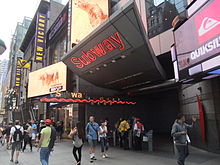
Many stations in the subway system have mezzanines.[149] Mezzanines allow for passengers to enter from multiple locations at an intersection and proceed to the correct platform without having to cross the street before entering. Inside mezzanines are fare control areas, where passengers physically pay their fare to enter the subway system.[149][150] In many older stations, the fare control area is at platform level with no mezzanine crossovers.[151] Many elevated stations also have platform-level fare control with no common station house between directions of service.[37]
Upon entering a station, passengers may use station booths (formerly known as token booths)[152] or vending machines to buy their fare, which is currently stored in a MetroCard or OMNY card. Each station has at least one booth, typically located at the busiest entrance.[153] After swiping the card at a turnstile, customers enter the fare-controlled area of the station and continue to the platforms.[17] Inside fare control are "Off-Hours Waiting Areas", which consist of benches and are identified by a yellow sign.[17][154][155]
Platforms
[edit]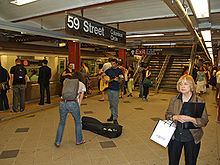
A typical subway station has waiting platforms ranging from 480 to 600 feet (150 to 180 m) long. Some are longer.[49][156] Platforms of former commuter rail stations—such as those on the IND Rockaway Line, are even longer. With the many different lines in the system, one platform often serves more than one service. Passengers need to look at the overhead signs to see which trains stop there and when, and at the arriving train to identify it.[17]
There are several common platform configurations. On a double track line, a station may have one center island platform used for trains in both directions, or two side platforms, one for each direction. For lines with three or four tracks with express service, local stops will have side platforms and the middle one or two tracks will not stop at the station. On these lines, express stations typically have two island platforms, one for each direction. Each island platform provides a cross-platform interchange between local and express services. Some four-track lines with express service have two tracks each on two levels and use both island and side platforms.[17]
Accessibility
[edit]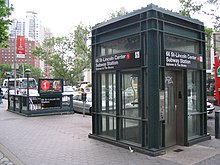
Since the majority of the system was built before 1990, the year the Americans with Disabilities Act (ADA) went into effect, many New York City Subway stations were not designed to be accessible to all.[157] Since then, elevators have been built in newly constructed stations to comply with the ADA. (Most grade-level stations required little modification to meet ADA standards.) Many accessible stations have AutoGate access.[17][158] In addition, the MTA identified "key stations", high-traffic and/or geographically important stations, which must conform to the ADA when they are extensively renovated. Under plans from the MTA in 2016, the number of ADA accessible stations would go up to 144 by 2020.[159] As of May 2024[update], there were 145 ADA-accessible stations.[160]
Over the years, the MTA has been involved in a number of lawsuits over the lack of accessibility in its stations. The Eastern Paralyzed Veterans Association filed what may have been the first of these suits in 1979, based on state law.[161] The lawsuits have relied on a number of different legal bases, but most have centered around the MTA's failure to include accessibility as a part of its plans for remodeling various stations.[162] As of January 2022[update], ADA-accessibility projects are expected to be started or completed at 51 stations as part of the 2020–2024 Capital Program.[163][164] This would allow one of every two to four stations on every line to be accessible, so that all non-accessible stops would be a maximum of two stops from an accessible station.[165]: 39
In 2022, the MTA agreed in a settlement to make 95 percent of subway and Staten Island Railway stations accessible by 2055.[166] By comparison, all but one of Boston's MBTA subway stations are accessible, the Chicago "L" plans all stations to be accessible in the 2030s,[167] the Toronto subway will be fully accessible by 2025,[168] and Montreal Metro plans all stations to be accessible by 2038.[169] Both the Boston and Chicago systems are as old or older than the New York City Subway, though all of these systems have fewer stations than the New York City Subway.[170][171] Newer systems like the Washington Metro and Bay Area Rapid Transit have been fully accessible from their opening in the 1970s.[172]
Rolling stock
[edit]
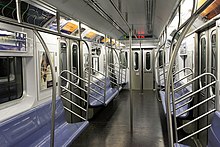
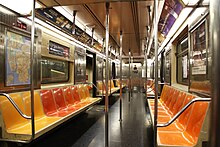
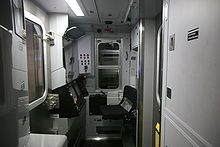
In November 2016, the New York City Subway had 6712 cars on the roster.[note 10] A typical New York City Subway train consists of 8 to 11 cars, although shuttles can have as few as two, and the train can range from 150 to 600 feet (46 to 183 m) in length.[173]
The system maintains two separate fleets of cars, one for the A Division routes and another for the B Division routes.[174] A Division equipment is approximately 8 feet 9 inches (2.67 m) wide and 51 feet 4 inches (15.65 m) long, whereas B Division equipment is about 10 feet (3.05 m) wide and either 60 feet 6 inches (18.44 m) or 75 feet (22.86 m) long.[175] The different lengths for the B Division fleet are necessary because 75-foot cars can not be used over the BMT Eastern Division.[176][177][dubious – discuss]
Cars purchased by the City of New York since the inception of the IND and the other divisions beginning in 1948 are identified by the letter "R" followed by a number; e.g.: R32.[174] This number is the contract number under which the cars were purchased.[178] Cars with nearby contract numbers (e.g.: R1 through R9, or R26 through R29, or R143 through R179) may be relatively identical, despite being purchased under different contracts and possibly built by different manufacturers.[179]
From 1999 to 2019, the R142, R142A, R143, R160, R179 and R188 were placed into service.[180][181] These cars are collectively known as New Technology Trains (NTTs) due to modern innovations such as LED and LCD route signs and information screens, as well as recorded train announcements and the ability to facilitate Communication-Based Train Control (CBTC).[181][182]
As part of the 2017–2020 MTA Financial Plan, 600 subway cars will have electronic display signs installed to improve customer experience.[183]
Fares
[edit]Riders pay a single fare to enter the subway system and may transfer between trains at no extra cost until they exit via station turnstiles; the fare is a flat rate regardless of how far or how long the rider travels. Thus, riders must swipe their MetroCard or tap a contactless payment card or smartphone on an OMNY reader upon entering the subway system, but not a second time upon leaving.[184]
As of August 2023[update], nearly all fares are paid by MetroCard or OMNY.[185] As of August 2023, the base fare is $2.90. Fares can be paid with most credit or debit cards using the OMNY readers, with a reusable MetroCard,[184] or with single-use tickets. The MTA offers 7-day and 30-day unlimited ride programs that can lower the effective per-ride fare significantly.[186] Reduced fares are available for the elderly and people with disabilities.[17][187]
Fares were stored in a money room at 370 Jay Street in Downtown Brooklyn starting in 1951, when the building opened as a headquarters for the New York City Board of Transportation.[188] The building is close to the lines of all three subway divisions (the IRT, BMT, and IND) and thus was a convenient location to collect fares, including tokens and cash, via money trains. Passageways from the subway stations, including a visible door in the Jay Street IND station, lead to a money sorting room in the basement of the building.[189][190] The money trains were replaced by armored trucks in 2006.[189][190][191]
MetroCard
[edit]
In June 1993, a fare system called the MetroCard was introduced, which allows riders to use magnetic stripe cards that store the value equal to the amount paid to a subway station booth clerk or vending machine.[192] The MetroCard was enhanced in 1997 to allow passengers to make free transfers between subways and buses within two hours and several MetroCard-only transfers between subway stations were added in 2001.[193][194] With the addition of unlimited-ride MetroCards in 1998, the New York City Transit system was the last major transit system in the United States with the exception of BART in San Francisco to introduce passes for unlimited bus and rapid transit travel.[195] As of 2024[update], MetroCard is to be retired at an undetermined date.[196]
OMNY
[edit]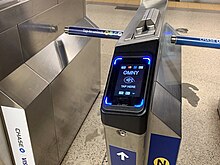
On October 23, 2017, it was announced that the MetroCard would be phased out and replaced by OMNY, a contactless fare payment system by San Diego-based Cubic Transportation Systems, with fare payment being made using Apple Pay, Google Pay, debit/credit cards with near-field communication technology, or radio-frequency identification cards.[197][198] As of December 31, 2020, OMNY is available on all MTA buses and at all subway stations.[199]
Modernization
[edit]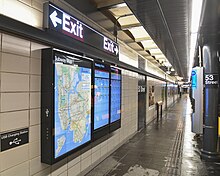
Since the late 20th century, the MTA has started several projects to maintain and improve the subway. In the 1990s, it started converting the BMT Canarsie Line to use communications-based train control, utilizing a moving block signal system that allowed more trains to use the tracks and thus increasing passenger capacity.[200] After the Canarsie Line tests were successful, the MTA expanded the automation program in the 2000s and 2010s to include other lines.[201][202] As part of another program called FASTRACK, the MTA started closing sections of lines during weekday nights in 2012, in order to allow workers to clean these lines without being hindered by train movements.[203] It expanded the program beyond Manhattan the next year after noticing how efficient the FASTRACK program was compared to previous service diversions.[204] In 2015, the MTA announced a wide-ranging improvement program as part of the 2015–2019 Capital Program. Thirty stations would be extensively rebuilt under the Enhanced Station Initiative, and new R211 subway cars would be able to fit more passengers.[205][206]
The MTA has also started some projects to improve passenger amenities. It added train arrival "countdown clocks" to most A Division stations (except on the IRT Flushing Line, serving the 7 and <7> trains) and the BMT Canarsie Line (L train) by late 2011, allowing passengers on these routes to see train arrival times using real-time data.[207] A similar countdown-clock project for the B Division and the Flushing Line was deferred[208] until 2016, when a new Bluetooth-based clock system was tested successfully.[209] Beginning in 2011, the MTA also started "Help Point" to aid with emergency calls or station agent assistance.[210] The Help Point project was deemed successful, and the MTA subsequently installed Help Points in all stations.[211] Interactive touchscreen "On The Go! Travel Station" kiosks, which give station advisories, itineraries, and timetables, were installed starting in 2011,[212] with the program also being expanded after a successful pilot.[213] Cellular phone and wireless data in stations, first installed in 2011 as part of yet another pilot program,[214] was also expanded systemwide due to positive passenger feedback.[211] Finally, credit-card trials at several subway stations in 2006 and 2010[215][216] led to proposals for contactless payment to replace the aging MetroCard.[217]
Safety and security
[edit]Signaling
[edit]Signaling has evolved during a century of operation, and MTA uses a mixture of old and new systems. Most routes use block signaling but a few routes are also being retrofitted with communications-based train control (CBTC), which would allow trains to run without train operator input.[218][219]
Wayside block signaling
[edit]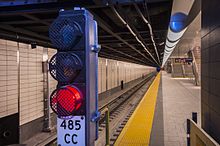
The system currently uses automatic block signaling with fixed wayside signals and automatic train stops to provide safe train operation across the whole system.[219] The New York City Subway system has, for the most part, used block signaling since its first line opened, and many portions of the current signaling system were installed between the 1930s and 1960s. These signals work by preventing trains from entering a "block" occupied by another train. Typically, the blocks are 1,000 feet (300 m) long.[220] Red and green lights show whether a block is occupied or vacant. The train's maximum speed will depend on how many blocks are open in front of it. The signals do not register a train's speed, nor where in the block the train is located.[221][222]
Subway trains are stopped mechanically at all signals showing "stop". To make train stops safe and effective, wayside trippers must not be moved to trip ("stop") position until the train has fully passed.[220][223]
Communications-based train control
[edit]In the late 1990s and early 2000s, the MTA began automating the subway by installing CBTC, which supplements rather than replaces the fixed-block signal system; it allows trains to operate more closely together with lower headways. The BMT Canarsie Line, on which the L train runs, was chosen for pilot testing because it is a self-contained line that does not operate in conjunction with other lines. CBTC became operational in February 2009.[224] Due to an unexpected ridership increase, the MTA ordered additional cars, and increased service from 15 trains to 26 trains per hour, an achievement beyond the capability of the block system.[225] The total cost of the project was $340 million.[220]
After the success of the BMT Canarsie Line automation, the IRT Flushing Line, carrying the 7 and <7> trains, was next chosen to get CBTC.[226] Estimated to cost US$1.4 billion,[227] the project was completed in November 2018.[228]: 11–12 By 2018, CBTC was in the process of being installed on several other routes as well, particularly the IND Queens Boulevard Line (E, F, <F>, M, and R trains) and IND Culver Line (F, <F>, and G trains).[228] The total cost for the entire Queens Boulevard Line is estimated at over $900 million,[229] and the Queens Boulevard CBTC project was completed in 2022.[183] Funding for CBTC on the IND Eighth Avenue Line is also provided in the 2015–2019 capital plan,[230] and the IND Crosstown Line[231] and IND Fulton Street Line were also being equipped with CBTC as of 2022[update].[232] The widespread installation of CBTC includes retrofitting many newer subway cars and replacement of older cars.[233]
Eventually, the MTA has plans to automate a much larger portion, using One Person Train Operation (OPTO) in conjunction with CBTC. At the current pace of installation, it would take 175 years for CBTC to be installed at a cost of $20 billion.[220] The Flushing line operated at almost 30 trains an hour using the signal system installed when the line was built, but after the CBTC installation it became possible that an additional two trains per hour could be operated.[234] In March 2018, New York City Transit Authority president Andy Byford announced a new plan for resignaling the subway with CBTC, which would only take 10 to 15 years, compared to the previous estimate of 40 years. This would cost $8 to $15 billion.[235][236]
The New York City Subway uses a system known as Automatic Train Supervision (ATS) for dispatching and train routing on the A Division[237] (the Flushing line and the trains used on the 7 and <7> services do not have ATS.)[237] ATS allows dispatchers in the Operations Control Center (OCC) to see where trains are in real time, and whether each individual train is running early or late.[237] Dispatchers can hold trains for connections, re-route trains, or short-turn trains to provide better service when a disruption causes delays.[237]
Train accidents
[edit]Despite the signal system, there have been at least 64 major train accidents since 1918, when a train bound for South Ferry collided with two trains halted near Jackson Avenue on the IRT White Plains Road Line in the Bronx.[238] Several accidents resulted when the train operator ran through red signals and rear-ended the subway train in front of it; this resulted from the signaling practice of "keying by", which allowed train operators to bypass red signals. The deadliest accident, the Malbone Street Wreck, occurred on November 1, 1918, beneath the intersection of Flatbush Avenue, Ocean Avenue, and Malbone Street (the latter of which is now Empire Boulevard) near the Prospect Park station of the then-BRT Brighton Line in Brooklyn, killing 93 people.[239] As a result of accidents, especially more recent ones such as the 1995 Williamsburg Bridge crash, timer signals were installed. These signals have resulted in reduced speeds across the system. Accidents such as derailments are also due to broken equipment, such as the rails and the train itself.[238]
Passenger safety
[edit]
Track safety and suicides
[edit]A portion of subway-related deaths in New York consists of suicides committed by jumping in front of an oncoming train. Between 1990 and 2003, 343 subway-related suicides were registered out of a citywide total of 7,394 (4.6%) and subway-related suicides increased by 30%, despite a decline in overall suicide numbers.[240]
Due to increase in people hit by trains in 2013,[241] in late 2013 and early 2014 the MTA started a test program, with four systems installed and strategies instituted to eliminate the number of people hit by trains. Closed-circuit television cameras, a web of laser beams stretched across the tracks, radio frequencies transmitted across the tracks, and thermal imaging cameras focused on the station's tracks were installed.[242] The tests were successful enough that the 2015–2019 capital program included similar installations system-wide.[243]
The MTA also expressed interest in starting a pilot program to install platform edge doors.[244] Several planned stations in the New York City Subway may possibly feature platform screen doors, including at future stations such as those part of the Second Avenue Subway.[245] In October 2017, it was announced that as part of a pilot program, the Third Avenue station would be refitted with platform screen doors during the 14th Street Tunnel shutdown in 2019–2020.[246] The $30 million for the platform edge door pilot program was diverted to another project in 2018.[247] Following a series of incidents, MTA announced another PSD pilot program at three stations in February 2022: the 7 and <7> trains' platform at Times Square; the E train's platform at Sutphin Boulevard–Archer Avenue–JFK Airport; and the Third Avenue station.[248] Numerous challenges come with platform doors. Some subway lines operate multiple subway car models, and their doors do not align.[249] Many platforms are not strong enough to hold the additional weight of a platform barrier, thus requiring extensive renovations if they were to be installed.[249]
Crime
[edit]Crime rates have varied, but there was a downward trend from the 1990s to 2014.[250] To fight crime, various approaches have been used over the years, including an "If You See Something, Say Something" campaign[251] and, starting in 2016, banning people who commit a crime in the subway system from entering the system for a certain length of time.[252]
In July 1985, the Citizens Crime Commission of New York City published a study showing riders abandoning the subway, fearing the frequent robberies and generally bad circumstances.[253] Crime rates in the subway and the city dropped in 1993, part of a larger citywide decrease in crime.[254] Michael Bloomberg stated in a November 2004 press release: "Today, the subway system is safer than it has been at any time since we started tabulating subway crime statistics nearly 40 years ago."[255] Although ridership decreased by 40 percent from 2019 to 2022, the number of crimes in the system remained roughly the same, prompting riders to express concerns over increased crime.[256][257] The subway recorded eight murders in 2021, the highest annual total in 25 years;[258] by October 2022, nine people had been murdered that year alone.[259][260]
The subway system has been the target of some mass attacks, though such attacks are relatively rare.[261] On December 11, 2017, there was an attempted bombing at the Times Square–42nd Street station, injuring four people including the attacker.[262] On April 12, 2022, a shooting attack occurred on the N train, injuring 29 people including 10 who were shot.[263]
Photography
[edit]After the September 11, 2001, attacks, the MTA exercised extreme caution regarding anyone taking photographs or recording video inside the system and proposed banning all photography and recording in a meeting around June 2004.[264] Due to strong response from both the public and from civil rights groups, the rule of conduct was dropped. In November 2004, the MTA again put this rule up for approval, but was again denied,[265] though many police officers and transit workers still confront or harass people taking photographs or videos.[266] On April 3, 2009, the NYPD issued a directive to officers stating that it is legal to take pictures within the subway system so long as it is not accompanied with suspicious activity.[267]
As of 2021[update], the MTA Rules of Conduct, Restricted Areas and Activities section states that anyone may take pictures or record videos, provided that they do not use any of three tools: lights, reflectors, or tripods. These three tools are permitted only by members of the press who have identification issued by the NYPD.[268]
Terrorism prevention
[edit]On July 22, 2005, in response to bombings in London, the New York City Police Department introduced a new policy of randomly searching passengers' bags as they approached turnstiles. The NYPD claimed that no form of racial profiling would be conducted when these searches actually took place. The NYPD has come under fire from some groups that claim purely random searches without any form of threat assessment would be ineffectual. Donna Lieberman, executive director of the NYCLU, stated, "This NYPD bag search policy is unprecedented, unlawful and ineffective. It is essential that police be aggressive in maintaining security in public transportation. But our very real concerns about terrorism do not justify the NYPD subjecting millions of innocent people to suspicionless searches in a way that does not identify any person seeking to engage in terrorist activity and is unlikely to have any meaningful deterrent effect on terrorist activity."[269] The searches were upheld by the United States Court of Appeals for the Second Circuit in MacWade v. Kelly.[270]
On April 11, 2008, MTA received a Ferrara Fire Apparatus Hazardous Materials Response Truck, which went into service three days later. It will be used in the case of a chemical or bioterrorist attack.[271]
Najibullah Zazi and others were arrested in September 2009 and pleaded guilty in 2010 to being part of an al-Qaeda plan to undertake suicide bombings on the New York City subway system.[272][273]
Challenges
[edit]2009–2010 budget cuts
[edit]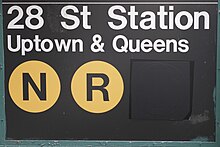
The MTA faced a budget deficit of US$1.2 billion in 2009.[274] This resulted in fare increases (three times from 2008 to 2010)[275] and service reductions (including the elimination of two part-time subway services, the V and W). Several other routes were modified due to the deficit. The N was made a full-time local in Manhattan (in contrast to being a weekend local/weekday express before 2010), while the Q was extended nine stations north to Astoria–Ditmars Boulevard on weekdays, both to cover the discontinued W. The M was combined with the V, routing it over the Chrystie Street Connection, IND Sixth Avenue Line and IND Queens Boulevard Line to Forest Hills–71st Avenue on weekdays instead of via the BMT Fourth Avenue Line and BMT West End Line to Bay Parkway. The G was truncated to Court Square full-time. Construction headways on eleven routes were lengthened, and off-peak service was lengthened on seven routes.[276]
2017–2021 state of emergency
[edit]In June 2017, Governor Andrew Cuomo signed an executive order declaring a state of emergency for the New York City Subway[277] after a series of derailments,[278][279] track fires,[280][281] and overcrowding incidents.[280][282] On June 27, 2017, thirty-nine people were injured when an A train derailed at 125th Street,[283][284] damaging tracks and signals[278] then catching fire.[278][285] On July 21, 2017, the second set of wheels on a southbound Q train jumped the track near Brighton Beach, with nine people suffering injuries[279] due to improper maintenance of the car in question.[286][287] To solve the system's problems, the MTA officially announced the Genius Transit Challenge on June 28, where contestants could submit ideas to improve signals, communications infrastructure, or rolling stock.[288][289]
On July 25, 2017, Chairman Joe Lhota announced a two-phase, $9 billion New York City Subway Action Plan to stabilize the subway system and to prevent the continuing decline of the system.[290][291][292][293] The first phase, costing $836 million, consisted of five categories of improvements in Signal and Track Maintenance, Car Reliability, System Safety and Cleanliness, Customer Communication, and Critical Management Group. The $8 billion second phase would implement the winning proposals from the Genius Transit Challenge and fix more widespread problems.[291][292][293] Six winning submissions for the Genius Transit Challenge were announced in March 2018.[294]
In October 2017, city comptroller Scott Stringer released an analysis that subway delays could cost up to $389 million or $243.1 million or $170.2 million per year depending on the length of the delays.[295] In November 2017, The New York Times published its investigation into the crisis. It found that the crisis had arisen as a result of financially unsound decisions by local and state politicians from both the Democratic and Republican parties. According to the Times, these decisions included overspending; overpaying unions and interest groups; advertising superficial improvement projects while ignoring more important infrastructure; and agreeing to high-interest loans that would have been unnecessary without these politicians' other interventions. By this time, the subway's 65% average on-time performance was the lowest among all major cities' transit systems, and every non-shuttle subway route's on-time performance had declined in the previous ten years.[296] The state of emergency ended on June 30, 2021, after previously being renewed 49 times.[297] As of October 2021[update], on-time performance across all routes is at 80.6 percent.[298] Worsening subway reliability and service cuts in the early 2020s have been attributed to chronic mismanagement at the agency and a botched restructuring plan that was implemented under former Governor Andrew Cuomo.[299]
Capacity constraints
[edit]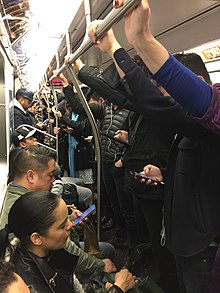
Several subway lines have reached their operational limits in terms of train frequency and passengers, according to data released by the Transit Authority. By 2007, the E, L, and all A Division services except the 42nd Street Shuttle were beyond capacity, as well as portions of the N train.[300][301] In April 2013, New York magazine reported that the system was more crowded than it had been in the previous 66 years.[302] The subway reached a daily ridership of 6 million for 29 days in 2014, and was expected to record a similar ridership level for 55 days in 2015; by comparison, in 2013, daily ridership never reached 6 million.[303] In particular, the express tracks of the IRT Lexington Avenue Line and IND Queens Boulevard Line are noted for operating at full capacity during peak hours.[300][304] The Long Island Rail Road East Side Access project, which opened in January 2023,[305] was expected to bring many more commuters to the Lexington Avenue Line.[306][307] The Second Avenue Subway was built to relieve pressure on the Lexington Avenue Line (4, 5, 6, and <6> trains) by shifting an estimated 225,000 passengers.[233] Following the onset of the COVID-19 pandemic in New York City in 2020, there was enough of a ridership decrease that these routes were no longer crammed to capacity during rush hours, although they still experienced some crowding.[308]
By early 2016, delays as a result of overcrowding were up to more than 20,000 every month, four times the amount in 2012. The overcrowded trains have resulted in an increase of assaults. With less platform space, more passengers are forced to be on the edge of the platform resulting in the increased possibility of passengers falling on the track. The MTA is considering platform screen doors, which exist on the AirTrain JFK to prevent passengers falling onto the tracks.[309] As of February 2022[update], platform screen doors were planned to be installed in three stations, following an increase in people being pushed onto the tracks.[248][310]
Expanding service frequency via CBTC
[edit]The MTA has sought to relieve overcrowding by upgrading signaling systems on some lines to use communications-based train control.[311] CBTC installation on the Flushing Line is expected to increase the rate of trains per hour on the 7 and <7> trains, but little relief will come to other crowded lines until later.[183] The L train, which is overcrowded during rush hours, already has CBTC operation.[312] The installation of CBTC has reduced the L's running time by 3%.[233] Even with CBTC, there are limits on the potential increased service. For L service to be increased further, a power upgrade as well as additional space for the L to turn around at its Manhattan terminus, Eighth Avenue, are needed.[127]
Service frequency and car capacity
[edit]Due to an increase of ridership, the MTA has tried to increase capacity wherever possible by adding more frequent service, specifically during the evening hours. This increase is not likely to keep up with the growth of subway ridership.[309][313][314] Some lines have capacity for additional trains during peak times, but there are too few subway cars for this additional service to be operated.[127]

As part of the R211 subway car order, the MTA is planning to test a train of 10 open-gangway experimental prototype cars, which could increase capacity by up to 10% by utilizing space between cars. The order could be expanded to include up to 750 open-gangway cars.[315][316][317]
Platform crowd control
[edit]The MTA is also testing smaller ideas on some services. Starting in late 2015, 100 "station platform controllers" were deployed for the F, 6, and 7 trains, to manage the flow of passengers on and off crowded trains during morning rush hours. There were a total of 129 such employees, who also answer passengers' questions about subway directions, rather than having conductors answer them and thus delaying the trains.[318][319][320][321] In early 2017, the test was expanded to the afternoon peak period with an increase of 35 platform conductors.[183][322] In November of the same year, 140 platform controllers and 90 conductors gained iPhone 6S devices so they could receive notifications of, and tell riders about, subway disruptions.[323] Subway guards, the predecessors to the platform controllers, were first used during the Great Depression and World War II.[309]
Shortened "next stop" announcements on trains were being tested on the 2 and 5 trains. "Step aside" signs on the platforms, reminding boarding passengers to let departing passengers off the train first, were tested at Grand Central–42nd Street, 51st Street, and 86th Street on the Lexington Avenue Line.[321][324] Cameras would also be installed so the MTA could observe passenger overcrowding.[233][325][326]
In systems like the London Underground, stations are simply closed off when they are overcrowded; that type of restriction is not necessary yet on the New York City Subway, according to MTA spokesman Kevin Ortiz.[309]
Subway flooding
[edit]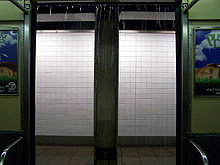
Service on the subway system is occasionally disrupted by flooding from rainstorms, even minor ones.[327] Rainwater can disrupt signals underground and require the electrified third rail to be shut off. Every day, the MTA moves 13 million gallons of water when it is not raining.[328] The pumps and drainage system can handle a rainfall rate of 1.75 inches (44 mm) per hour.[328][329]: 10 Since 1992, $357 million has been used to improve 269 pump rooms. By August 2007, $115 million was earmarked to upgrade the remaining 18 pump rooms.[330]
Despite these improvements, the transit system continues to experience flooding problems. On August 8, 2007, after more than 3 inches (76 mm) of rain fell within an hour, the subway system flooded, causing almost every subway service to either be disabled or seriously disrupted, effectively halting the morning rush.[331] On September 1, 2021, when 3 to 5 inches (76 to 127 mm) of rain per hour fell during Hurricane Ida, service on the entire subway system was suspended.[332]
As part of a $130 million and an estimated 18-month project, the MTA began installing new subway grates in September 2008 in an attempt to prevent rain from overflowing into the subway system. The metallic structures, designed with the help of architectural firms and meant as a piece of public art, are placed atop existing grates but with a 3-to-4-inch (76 to 102 mm) sleeve to prevent debris and rain from flooding the subway. The racks will at first be installed in the three most flood-prone areas as determined by hydrologists: Jamaica, Tribeca, and the Upper West Side. Each neighborhood has its own distinct design, some featuring a wave-like deck which increases in height and features seating (as in Jamaica), others with a flatter deck that includes seating and a bike rack.[333][334][335]
In October 2012, Hurricane Sandy caused significant damage to New York City, and many subway tunnels were inundated with floodwater. The subway opened with limited service two days after the storm and was running at 80 percent capacity within five days; some infrastructure needed years to repair. A year after the storm, MTA spokesperson Kevin Ortiz said, "This was unprecedented in terms of the amount of damage that we were seeing throughout the system."[336][337] The storm flooded nine of the system's 14 underwater tunnels, many subway lines, and several subway yards, as well as completely destroying a portion of the IND Rockaway Line and much of the South Ferry terminal station. Reconstruction required many partial or total closures on several lines and tunnels.[338] Heavy flooding also occurred in September 2021 during Hurricane Ida[339] and in September 2023 during the aftermath of Tropical Storm Ophelia.[340]
- Flooding at 125th Street after a water main break
- Preparations for Hurricane Sandy at Bowling Green
- South Ferry after Hurricane Sandy
- Pump train in the Cranberry Street Tube after Hurricane Sandy
Full and partial subway closures
[edit]
Before 2011 there have been some full subway closures for transit strikes (January 1–13, 1966,[341] April 1–11, 1980,[342] December 20–22, 2005)[343] and blackouts (November 9–10, 1965,[344] July 13–14, 1977,[345] August 14–16, 2003[346]).
On August 27, 2011, due to the approach of Hurricane Irene, the MTA suspended subway service at noon in anticipation of heavy flooding on tracks and in tunnels. It was the first weather-caused shutdown in the history of the system.[347] Service was restored by August 29.[348][349]
On October 29, 2012, a full closure was ordered before the arrival of Hurricane Sandy.[337] All services on the subway, the Long Island Rail Road and Metro-North were gradually shut down by 7:00 P.M. to protect passengers, employees, and equipment from the coming storm.[350] The storm caused serious damage to the system, especially the IND Rockaway Line, upon which many sections between Howard Beach–JFK Airport and Hammels Wye on the Rockaway Peninsula were heavily damaged, leaving it essentially isolated from the rest of the system.[351][352] This required the NYCTA to truck in 20 R32 subway cars to the line to provide some interim service (temporarily designated the H).[353][354][355] Also, several of the system's tunnels under the East River were flooded by the storm surge.[356] South Ferry suffered serious water damage and did not reopen until April 4, 2013, by restoring service to the older loop-configured station that had been replaced in 2009;[357][358] the stub-end terminal tracks remained out of service until June 2017.[359][360][361][362]
Since 2015, there have been several blizzard-related subway shutdowns. On January 26, 2015, another full closure was ordered by New York Governor Andrew Cuomo due to the January 2015 nor'easter, originally projected to leave New York City with 20 to 30 inches (51 to 76 cm) of snow; this was the first shutdown in the system's history to be ordered due to snow.[363] The next day, the subway system was partially reopened.[364][365] Several residents criticized the decision to shut down the subway system due to snow, as the nor'easter dropped much less snow in the city than originally expected, totaling only 9.8 inches (25 cm) in Central Park.[366][367] For subsequent snowstorms, the MTA published a winter underground-only subway service plan. When this plan is in effect, all above-ground stations would be closed and all above-ground service suspended, except at 125th Street and Broadway, where 1 trains would run above ground but skip the station. Underground service would remain operational, except at a small number of stations that would be closed because of their proximity to above-ground portions of the system.[368] This plan was first used on January 23, 2016, during the January 2016 United States blizzard;[369] it was also used on March 14, 2017, due to the March 2017 nor'easter.[370] On August 4, 2020, service at above-ground stations was suspended due to the high wind gusts brought by Tropical Storm Isaias.[371]
Starting on May 6, 2020, as a result of the COVID-19 pandemic in New York City, stations were closed between 1:00 a.m. and 5:00 a.m. for cleaning and disinfecting.[372][373] Nevertheless, over 500 trains continued running every 20 minutes between 1 a.m. and 5 a.m., carrying only transit workers and emergency personnel. The trains kept running because there was not enough space in the system to store all trains simultaneously, and also so that they could easily resume service upon the start of rush hour at 5 a.m.[374] In February 2021, the overnight closures were shortened to between 2 and 4 a.m.,[375][376] and in May 2021, Cuomo announced that 24-hour service would resume on May 17.[377][378] This was the longest shutdown in the subway's history.[379]
- Snow removal during the 2014 snow storm
- Closed turnstiles during the COVID-19 pandemic
- Fallen tree during Hurricane Isaias
Litter and rodents
[edit]Litter accumulation in the subway system is perennial. In the 1970s and 1980s, dirty trains and platforms, as well as graffiti, were a serious problem. The situation had improved since then, but the 2010 budget crisis, which caused over 100 of the cleaning staff to lose their jobs, threatened to curtail trash removal.[380][381] Every day, the MTA removes 40 tons of trash from 3,500 trash receptacles.[382]
The New York City Subway system is infested with rats.[383] Rats are sometimes seen on platforms,[384] and are commonly seen foraging through garbage thrown onto the tracks. They are believed to pose a health hazard, and on rare instances have been known to bite humans.[385] Subway stations notorious for rat infestation include Chambers Street, Jay Street–MetroTech, West Fourth Street, Spring Street and 145th Street.[386]
Decades of efforts to eradicate or simply thin the rat population in the system have been a failure. In March 2009, the Transit Authority announced a series of changes to its vermin control strategy, including new poison formulas and experimental trap designs.[387] In October 2011, they announced a new initiative to clean 25 subway stations, along with their garbage rooms, of rat infestations.[388] That same month, the MTA announced a pilot program aimed at reducing levels of garbage in the subways by removing all garbage bins from the subway platforms. The initiative was tested at the Eighth Street–New York University and Flushing–Main Street stations.[389] As of March 2016, stations along the BMT Jamaica Line, BMT Myrtle Avenue Line, and various other stations had their garbage cans removed due to the success of the program.[390] In March 2017 the program was ended as a failure.[391]
The old vacuum trains that are designed to remove trash from the tracks are ineffective and often broken.[390] A 2016 study by Travel Math had the New York City Subway listed as the dirtiest subway system in the country based on the number of viable bacteria cells.[392] In August 2016, the MTA announced that it had initiated Operation Track Sweep, an aggressive plan to dramatically reduce the amount of trash on the tracks and in the subway environment. This was expected to reduce track fires and train delays. As part of the plan, the frequency of station track cleaning would be increased, and 94 stations would be cleaned per two-week period, an increase from the previous rate of 34 stations every two weeks.[382] The MTA launched an intensive two-week, system-wide cleaning on September 12, 2016.[393] Several vacuum trains were delivered in 2018 and 2019.[394] The operation planned to also include 27 new refuse cars.[395]
- Typical subway car exterior in the late 1970s
- Measures against rats
- Program for removing garbage bins from stations
Noise
[edit]Rolling stock on the New York City Subway produces high levels of noise that exceed guidelines set by the World Health Organization and the U.S. Environmental Protection Agency.[396] In 2006, Columbia University's Mailman School of Public Health found noise levels averaged 95 decibel (dB) inside subway cars and 94 dB on platforms.[396] Daily exposure to noise at such levels for as little as 30 minutes can lead to hearing loss.[396] Noise on one in 10 platforms exceeded 100 dB.[396] Under WHO and EPA guidelines, noise exposure at that level is limited to 1.5 minutes.[396] A subsequent study by Columbia and the University of Washington found higher average noise levels in the subway (80.4 dB) than on commuter trains including Port Authority Trans-Hudson (PATH) (79.4 dB), Metro-North (75.1 dB) and Long Island Rail Road (LIRR) (74.9 dB).[397] Since the decibel scale is a logarithmic scale, sound at 95 dB is 10 times more intense than at 85 dB, 100 times more intense than at 75 dB, and so forth.[397] In the second study, peak subway noise registered at 102.1 dB.[397]
For the construction of the Second Avenue Subway, the MTA, with the engineering firm Arup, worked to reduce the noise levels in stations. In order to reduce noise for all future stations starting with the Second Avenue Subway, the MTA is investing in low-vibration track using ties encased in concrete-covered rubber and neoprene pads. Continuously welded rail, which is also being installed, reduces the noise being made by the wheels of trains. The biggest change that is going to be made is in the design of stations. Current stations were built with tile and stone, which bounce sound everywhere, while newer stations will have the ceilings lined with absorbent fiberglass or mineral wool that will direct sound toward the train and not the platform. With less noise from the trains, platform announcements could be heard more clearly. They will be clearer with speakers spaced periodically on the platform, angled so that announcements can be heard by the riders. The Second Avenue Subway has the first stations to test this technology.[398]
Public relations and cultural impact
[edit]Entertainment
[edit]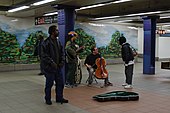
The subway is a popular venue for busking. A permit is not required to perform, but certain codes of conduct are required.[399] Some buskers are affiliated with Music Under New York (MUNY), a part of the Arts & Design program by the MTA. Since 1987, MTA has sponsored the MUNY program[400] in which street musicians enter a competitive contest to be assigned to the preferred high traffic locations. Each year, applications are reviewed and approximately 70 eligible performers are selected and contacted to participate in live auditions held for one day.[401][402][403][404]
Miss Subways
[edit]
From 1941 to 1976, the Board of Transportation/New York City Transit Authority sponsored the "Miss Subways" publicity campaign.[405] In the musical On the Town, the character Miss Turnstiles is based on the Miss Subways campaign.[406][407] The campaign was resurrected in 2004, for one year, as "Ms. Subways". It was part of the 100th anniversary celebrations. The monthly campaign, which included the winners' photos and biographical blurbs on placards in subway cars, featured such winners as Mona Freeman and prominent New York City restaurateur Ellen Goodman. The winner of this contest was Caroline Sanchez-Bernat, an actress from Morningside Heights.[408]
Subway Series
[edit]Subway Series is a term applied to any series of baseball games between New York City teams, as opposing teams can travel to compete merely by using the subway system. Subway Series is a term long used in New York, going back to series between the Brooklyn Dodgers or New York Giants and the New York Yankees in the 1940s and 1950s. Today, the term is used to describe the rivalry between the Yankees and the New York Mets. During the 2000 World Series, cars on the 4 train (which stopped at Yankee Stadium) were painted with Yankee colors, while cars on the 7 train (which stopped at Shea Stadium) had Mets colors.[409]
Holiday Nostalgia Train
[edit]
Since 2003, the MTA has operated a Holiday Nostalgia Train on Sundays in November and December, from the first Sunday after Thanksgiving to the Sunday before Christmas Day,[410] except in 2011 and 2023, when the train operated on Saturdays instead of Sundays.[411] This train is made of vintage cars from the R1–9 fleet, which have been preserved by Railway Preservation Corp. and the New York Transit Museum. Until 2017, the train made all stops between Second Avenue in Manhattan and Queens Plaza in Queens via the IND Sixth Avenue Line and the IND Queens Boulevard Line. In 2017, the train ran between Second Avenue and 96th Street via the newly opened Second Avenue Subway.[412] Since 2018, the northern terminal is now located at 145th Street.
The contract, car numbers (and year built) used generally comprises R1 100 (built 1930), R1 103 (1930), R1 381 (1931), R4 401 (1932), R4 484 (1932) – Bulls Eye lighting and a test P.A. system added in 1946, R6-3 1000 (1935), R6-1 1300 (1937), R7A 1575 (1938) – rebuilt in 1947 as a prototype for the R10 subway car, and R9 1802 (1940).[413]
Full train wraps
[edit]Since 2008, the MTA has tested full train wraps on 42nd Street Shuttle rolling stock. In full train wraps, advertising entirely covers the interiors and exteriors of the train, as opposed to other routes, whose stock generally only displays advertising on placards inside the train.[414][415] While most advertisements are well received, a few advertisements have been controversial. Among the more contentious wraps that were withdrawn are a 2015 ad for the TV show The Man in the High Castle, which featured a Nazi flag,[416][417] and an ad for Fox Sports 1, in which a shuttle train and half of its seats were plastered with negative quotes about the New York Knicks, one of the city's NBA teams.[418][419]
Other routes have seen limited implementation of full train wraps. For instance, in 2010, one R142A train set on the 6 route was wrapped with a Target advertisement.[420] In 2014, the Jaguar F-Type was advertised on train sets running on the F route.[421][422] Some of these wraps have also been controversial, such as a Lane Bryant wrap in 2015 that displayed lingerie models on the exteriors of train cars.[423]
LGBT Pride-themed trains and MetroCards
[edit]
The New York City Subway system commemorates Pride Month in June with Pride-themed posters.[424] The MTA celebrated Stonewall 50 - WorldPride NYC 2019 in June 2019 with rainbow-themed Pride logos on the subway trains as well as Pride-themed MetroCards.[425]
Guerrilla art
[edit]The New York City Subway system has been a target for unauthorized or "guerrilla" art since the 1970s, beginning with graffiti and tagging. Originally thought of as vandalism, the art form eventually emerged as an authoritative typology in the 1980s, especially with the release of the 1983 documentary Style Wars. Prominent pop-artist Keith Haring got his start tagging blank billboards on subway platforms with chalk art.[426] In 2019–2020, the Bronx Museum mounted an exhibition of graffiti-tagged subway cars.[427]
More contemporary installations have taken place as well. In 2014, artist London Kaye yarn-bombed the L train, wrapping metal hand poles in knit fabric.[428] In 2019, artist Ian Callender used projectors to show accurate views of the cityscape above moving 6 trains on the ceilings of entire cars.[429] In 2021, illustrator Devon Rodriguez went viral for his drawings of fellow commuters.[430]
No Pants Ride
[edit]In 2002, the New York City Subway began hosting an event called the No Pants Subway Ride, where people ride the subway without their pants. The event is typically held each January but has not been held since 2020 due to the COVID-19 pandemic.[431]
See also
[edit]Notes
[edit]- ^ These are the physical tracks that a train "service" runs on. See New York City Subway nomenclature for more information.
- ^ These "services" run on physical tracks. See New York City Subway nomenclature for more information.
- ^ a b There are 13 stations on the IND Second Avenue Line and 1 station on the IRT Flushing Line planned.
- The Second Avenue Line has 3 active stations.[2] 13 of these are planned.[3]
- The Tenth Avenue station will be constructed as an in-fill station once funding for it is secured.[4]
- ^ a b
- Permanently closed stations are not counted.[5]
- Both the Chambers Street–World Trade Center (IND Eighth Avenue Line) and Canal Street (BMT Broadway Line) stations are considered two stations each by the MTA.[5] If both of them are counted as one station each, the number of stations in the New York City Subway is 470 stations (or 423 by international standards).
- ^ a b This figure represents unlinked ridership, meaning one ride is counted each time a passenger boards a vehicle. The MTA reports a 2023 ridership of 1,151,998,158 based on linked ridership, meaning each complete journey from beginning to end is counted as one ride, regardless of the number of different vehicles used.[19]
- ^ The IRT main line, which is considered to be the first New York City "subway" line, opened in 1904; the Ninth Avenue Line, a predecessor elevated railroad line, operated its first trial run on July 3, 1868, according to Facts and Figures 1979–80, published by the New York City Transit Authority See also nycsubway.org Archived October 7, 2008, at the Wayback Machine; and the West End Line, which opened in 1863. A small portion of the latter line's original right-of-way, part of an extension opened in 1864, is still in daily use near Coney Island. thethirdrail.net Archived May 23, 2006, at the Wayback Machine
- ^ There is one station (10th Avenue) planned as a future infill station. See Outcry emerges for 41st St. stop on new 7-line
- ^ See also FASTRACK
- ^ The Times Square and Grand Central stations of the IRT 42nd Street Shuttle are closed during late nights.
- ^ See:
- Korman, Joe (December 4, 2017). "IRT Car Assignments". JoeKorNer.
- Korman, Joe (January 12, 2018). "BMT-IND Car Assignments". JoeKorNer.
References
[edit]- ^ a b c "Introduction to Subway Ridership". Metropolitan Transportation Authority. Archived from the original on September 12, 2014. Retrieved July 12, 2018.
- ^ "web.mta.info/capital/sas_docs/final_summary_report.pdf" (PDF). Archived (PDF) from the original on November 7, 2016. Retrieved April 17, 2014.
- ^ "MTA releases Second Avenue subway images". New York Daily News. November 5, 2013. Archived from the original on November 24, 2021. Retrieved April 17, 2014.
- ^ "Outcry emerges for 41st St. stop on new 7-line".
- ^ a b "Station Developers' Information". Metropolitan Transportation Authority. Retrieved June 13, 2017.
- ^ a b "Transit Ridership Report Fourth Quarter 2023" (PDF). American Public Transportation Association. March 4, 2024. Retrieved September 5, 2024.
- ^ "Fifty Years of Rapid Transit (1918)". Archived from the original on February 5, 2023. Retrieved January 5, 2018.
- ^ "2025–2029 CAPITAL PLAN: The Future Rides With Us". Metropolitan Transportation Authority. Retrieved September 18, 2024.
- ^ a b "MTA A Subway Timetable". MTA. Archived from the original on December 12, 2021. Retrieved June 26, 2022.
- ^ a b c d "Comprehensive Annual Financial Report for the Years Ended December 31, 2018 and 2017" (PDF). Metropolitan Transportation Authority (MTA). June 26, 2019. p. 156. Archived (PDF) from the original on October 23, 2021. Retrieved January 15, 2021.
- ^ a b c d e "Facts & Figures – Subways". www.nycsubway.org. Archived from the original on June 18, 2012. Retrieved March 9, 2014.
- ^ "The Railway Power Stations of New York City". Engineering and Technology History. Archived from the original on March 11, 2022. Retrieved September 13, 2016.
- ^ a b "Average schedule speed: How does Metro compare?". Archived from the original on December 8, 2015. Retrieved July 16, 2015.
- ^ a b Hood, Clifton (2004). 722 Miles: The Building of the Subways and How They Transformed New York. Johns Hopkins University Press. ISBN 978-0801880544.
- ^ "Metropolitan Transportation Authority Description and Board Structure Covering Fiscal Year 2009" (PDF). mta.info. Metropolitan Transportation Authority. 2009. Archived (PDF) from the original on December 7, 2015. Retrieved March 13, 2016.
- ^ "What is the largest metro system in the world?". CityMetric. Archived from the original on September 6, 2015. Retrieved March 13, 2016.
- ^ a b c d e f g h i j "How to Ride the Subway". Archived from the original on July 5, 2022. Retrieved May 12, 2013.
- ^ "Subways". Metropolitan Transportation Authority (MTA). April 2, 2013. Archived from the original on June 22, 2013. Retrieved April 26, 2015.
- ^ "Subway and bus ridership for 2022". mta.info. Metropolitan Transportation Authority. 2023. Archived from the original on August 3, 2023. Retrieved August 3, 2023.
- ^ "NYC Subway Broke Its Single-Day Ridership Record In October". ny.curbed.com. December 11, 2015. Archived from the original on February 25, 2024. Retrieved October 30, 2021.
- ^ Goldstein, Jack (2013). 101 Amazing Facts About New York. Andrews UK Limited. ISBN 978-1783333059.
- ^ Rivoli, Dan (February 13, 2018). "MTA Budget: Where does the money go?". NY Daily News. Archived from the original on November 3, 2018. Retrieved November 3, 2018.
- ^ a b Brennan, Joseph (2005). ""They found the tube in excellent condition"". Beach Pneumatic. Archived from the original on October 6, 2007. Retrieved January 17, 2008.
- ^ "Inventor of the Week: Archive – Alfred Beach (1826–1896)". Lemelson-MIT Program. Archived from the original on March 6, 2014. Retrieved March 18, 2016.
- ^ ""The Pneumatic Tunnel Under Broadway" (1870)". nycsubway.org. Scientific American. March 5, 1870. Archived from the original on May 5, 2008. Retrieved July 7, 2008.
- ^ nycsubway.org – "Beach Pneumatic Transit". Archived April 24, 2021, at the Wayback Machine.
- ^ Blankinger, Kari (March 1, 2016). "NYC's first subway was luxurious, pneumatic and built illegally". New York Daily News. Archived from the original on November 24, 2021. Retrieved March 13, 2016.
- ^ Martin, Douglas (November 17, 1996). "Subway Planners' Lofty Ambitions Are Buried as Dead-End Curiosities". The New York Times. Archived from the original on August 7, 2017. Retrieved June 27, 2015.
- ^ Santora, Marc (August 14, 2013). "When the New York City Subway Ran Without Rails". The New York Times. Archived from the original on June 26, 2022. Retrieved February 11, 2017.
- ^ Christiano, G. J. "The Blizzard of 1888; the Impact of this Devastating Storm on New York Transit". nycsubway.org. Archived from the original on May 4, 2022. Retrieved February 9, 2016.
- ^ a b "American Experience. Technology . New York Underground. About the Program". PBS. Archived from the original on August 29, 2016. Retrieved March 13, 2016.
- ^ "Done at Last". Brooklyn Daily Eagle. Brooklyn, NY. May 13, 1885. p. 1.
- ^ "Halsey Street Station Opened". Brooklyn Daily Eagle. Brooklyn, NY. August 19, 1885. p. 4.
- ^ "A New Station Opened". Brooklyn Daily Eagle. Brooklyn, NY. July 18, 1885. p. 4.
- ^ "East New York". Brooklyn Daily Eagle. Brooklyn, NY. June 13, 1885. p. 6.
- ^ "Still Extending Its Lines". Brooklyn Daily Eagle. Brooklyn, NY. September 5, 1885. p. 6.
- ^ a b "www.nycsubway.org: BMT Nassau Street-Jamaica Line". www.nycsubway.org. Archived from the original on September 25, 2022. Retrieved February 25, 2016.
- ^ "Opening of a New Railroad". Brooklyn Daily Eagle. Brooklyn, NY. October 5, 1863. p. 2.
- ^ "Railroads". Brooklyn Daily Eagle. Brooklyn, NY. October 9, 1863. p. 1.
- ^ "The Third Rail – Gunther and his Railroad – page 1". www.thethirdrail.net. Archived from the original on February 29, 2016. Retrieved February 14, 2016.
- ^ a b c Walker, James Blaine (1918). Fifty Years of Rapid Transit, 1864–1917. Law Print. Company.
- ^ "The 9th Avenue Elevated-Polo Grounds Shuttle". nycsubway.org. 2012. Archived from the original on September 26, 2013. Retrieved July 3, 2014.
- ^ "EXERCISES IN CITY HALL.; Mayor Declares Subway Open – Ovations for Parsons and McDonald". The New York Times. October 28, 1904. Archived from the original on May 4, 2022. Retrieved December 16, 2018.
- ^ "Our Subway Open, 150,000 Try It – Mayor McClellan Runs the First Official Train" (PDF). The New York Times. October 28, 1904. Archived (PDF) from the original on September 18, 2018. Retrieved February 24, 2016.
- ^ a b 1634–1699: McCusker, J. J. (1997). How Much Is That in Real Money? A Historical Price Index for Use as a Deflator of Money Values in the Economy of the United States: Addenda et Corrigenda (PDF). American Antiquarian Society. 1700–1799: McCusker, J. J. (1992). How Much Is That in Real Money? A Historical Price Index for Use as a Deflator of Money Values in the Economy of the United States (PDF). American Antiquarian Society. 1800–present: Federal Reserve Bank of Minneapolis. "Consumer Price Index (estimate) 1800–". Retrieved February 29, 2024.
- ^ "Specter of the 5¢ fare haunts the current fare hike debate". Second Ave. Sagas. November 21, 2007. Archived from the original on November 24, 2021. Retrieved February 25, 2016.
- ^ "www.nycsubway.org: New Subways for New York: The Dual System of Rapid Transit (1913)". www.nycsubway.org. Archived from the original on August 24, 2012. Retrieved February 26, 2016.
- ^ "Gay Midnight Crowd Rides First Trains in New Subway". The New York Times. September 10, 1932. p. 1. Archived from the original on September 12, 2012. Retrieved February 11, 2017.
- ^ a b Feinman, Mark S. (2000). "History of the Independent Subway". nycsubway.org. Archived from the original on December 25, 2017. Retrieved February 10, 2016.
- ^ Cudahy, Brian J. (1995). Under the Sidewalks of New York: The Story of the Greatest Subway System in the World. Fordham University Press. p. 118. ISBN 978-0823216185. Archived from the original on February 25, 2024. Retrieved November 18, 2020.
- ^ "Straphangers Sit As Tunnel Opens". The New York Times. December 2, 1955. p. 29. Archived from the original on November 2, 2012. Retrieved February 13, 2010.
- ^ Perlmutter, Emanuel (November 16, 1967). "Subway Changes to Speed Service: Major Alterations in Maps, Routes and Signs Will Take Effect Nov. 26" (PDF). The New York Times. Archived from the original on October 30, 2021. Retrieved July 7, 2015.
- ^ a b Raskin, Joseph B. (2013). The Routes Not Taken: A Trip Through New York City's Unbuilt Subway System. New York, New York: Fordham University Press. doi:10.5422/fordham/9780823253692.001.0001. ISBN 978-0-82325-369-2.
- ^ "A Division". August 6, 2011. Archived from the original on August 6, 2011. Retrieved February 14, 2016.
- ^ a b Sparberg, Andrew J. (2014). From a Nickel to a Token: The Journey from Board of Transportation to MTA. Fordham University Press. ISBN 978-0823261901.
- ^ Cunningham, Joseph; DeHart, Leonard O. (1993). A History of the New York City Subway System. J. Schmidt, R. Giglio, and K. Lang. Archived from the original on February 25, 2024. Retrieved November 18, 2020.
- ^ "mta.info | Facts and Figures". web.mta.info. Archived from the original on January 6, 2010. Retrieved March 11, 2016.
- ^ "Transport Workers Union Our History". www.twu.org. Archived from the original on February 9, 2016. Retrieved February 16, 2016.
- ^ B. Freeman, Joshua (1989). In Transit:The Transport Workers Union In New York City, 1933–1966. Temple University Press. ISBN 978-1592138159. Archived from the original on August 5, 2023. Retrieved February 28, 2016.
- ^ "A Short History of Recent American Transit Strikes". The Transport Politic. August 14, 2009. Archived from the original on January 22, 2022. Retrieved February 16, 2016.
- ^ "A look back at the historic 1966 transit strike: Photos and more". am New York. January 7, 2016. Archived from the original on November 24, 2021. Retrieved February 16, 2016.
- ^ "35 Years Ago This Week, the MTA Strikes for 11 Days in NYC Bringing Transit to a Halt". Untapped Cities. April 7, 2015. Archived from the original on February 20, 2016. Retrieved February 16, 2016.
- ^ Steinhauer, Jennifer (December 21, 2005). "Citywide Strike Halts New York Subways and Buses". The New York Times. ISSN 0362-4331. Archived from the original on July 4, 2022. Retrieved February 16, 2016.
- ^ "NYC Transit Workers On Strike". CBS News. December 19, 2005. Archived from the original on November 24, 2021. Retrieved February 16, 2016.
- ^ nycsubway.org – The New York Transit Authority in the 1970s Archived July 6, 2022, at the Wayback Machine
- ^ a b nycsubway.org – The New York Transit Authority in the 1980s Archived July 6, 2022, at the Wayback Machine
- ^ Lorch, Donatella (October 29, 1989). "The 'Subway to Nowhere' Now Goes Somewhere". The New York Times. Archived from the original on March 19, 2011. Retrieved October 20, 2011.
- ^ Johnson, Kirk (December 9, 1988). "Big Changes For Subways Are to Begin". The New York Times. Archived from the original on March 8, 2021. Retrieved July 5, 2009.
- ^ Lentz, Phillip (May 18, 1989). "Graffiti Cleanup A Shiny Symbol Of Subway System's Turnaround". Chicago Tribune. Archived from the original on March 12, 2016. Retrieved March 11, 2016.
- ^ U.S. Department of Transportation Research and Special Programs Administration, Volpe National Transportation Systems Center (April 2002). "Effects of Catastrophic Events on Transportation System Management and Operations: New York City – September 11". Archived from the original on March 5, 2013. Retrieved November 5, 2013.
- ^ Kennedy, Randy. "Tunnel Vision; With Station's Reopening, Even Commuters Smile" Archived November 1, 2020, at the Wayback Machine, The New York Times, September 17, 2002. Accessed October 6, 2007.
- ^ "1 9 2 3 Service Restored" (PDF). mta.info. September 15, 2002. Archived from the original (PDF) on July 16, 2003. Retrieved December 25, 2017.
- ^ "September 11: Three Years Later". Brian Abbott. September 11, 2004. Archived from the original on March 14, 2016. Retrieved March 25, 2016.
- ^ Fitzsimmons, Emma G.; Hu, Winnie (September 8, 2018). "Cortlandt Street Station, Damaged on Sept. 11, Reopens 17 Years Later". The New York Times. Archived from the original on September 8, 2018. Retrieved September 8, 2018.
- ^ "mta.info: Superstorm Sandy Timeline". Archived from the original on November 14, 2018.
- ^ Brachfeld, Ben (December 27, 2022). "MTA surpasses 1 billion subway riders in 2022, a first in COVID era". amNewYork. Archived from the original on October 17, 2023. Retrieved October 3, 2023.
- ^ a b c d "The New York Subway: Chapter 02, Types and Methods of Construction". nycsubway.org. Archived from the original on February 17, 2022. Retrieved November 1, 2015.
- ^ "Why It Was Faster To Build Subways in 1900". Atlas Obscura. October 22, 2015. Archived from the original on May 17, 2022. Retrieved April 15, 2016.
- ^ "www.nycsubway.org: Design and Construction of the IRT: Civil Engineering (Scott)". www.nycsubway.org. Archived from the original on August 5, 2022. Retrieved April 15, 2016.
- ^ "Subway Construction: Then and Now". The New York Public Library. Archived from the original on June 11, 2022. Retrieved April 15, 2016.
- ^ "Subway FAQ: Facts and Figures". nycsubway.org. Archived from the original on June 21, 2013. Retrieved February 26, 2016.
- ^ "MTA has been leaving dangerous debris exposed for years: conductor". New York Post. February 23, 2019. Archived from the original on February 23, 2019. Retrieved February 23, 2019.
- ^ "www.nycsubway.org: IRT White Plains Road Line". www.nycsubway.org. Archived from the original on May 14, 2021. Retrieved February 26, 2016.
- ^ Cox, Jeremiah. "Myrtle Av-Broadway (J, M, Z) – The SubwayNut". www.subwaynut.com. Archived from the original on March 12, 2018. Retrieved February 26, 2016.
- ^ Dougherty, Peter (2006) [2002]. Tracks of the New York City Subway 2006 (3rd ed.). Dougherty. OCLC 49777633 – via Google Books.
- ^ DuTemple, Lesley A. (2002). The New York Subways. Twenty-First Century Books. ISBN 978-0822503781. Archived from the original on February 25, 2024. Retrieved January 28, 2016.
- ^ MacKechnie, Christopher. "The Two Methods of Subway Construction". about.com. Archived from the original on December 10, 2016. Retrieved May 7, 2014.
In exchange for these advantages are two major disadvantages. One is financial: "deep bore" construction costs significantly more than 'cut and cover'
- ^ "No. 7 Subway Line Extension". Richard Dattner & Partners Architects. Archived from the original on March 15, 2012. Retrieved February 28, 2010.
- ^ "West Side Development Project Gets The Green Light". NY1. December 21, 2009. Archived from the original on April 7, 2012. Retrieved February 28, 2010.
- ^ Cuza, Bobby (February 19, 2009). "Crews Lower Giant Drill Into 7 Line Tunnel". NY1. Archived from the original on May 5, 2009. Retrieved February 28, 2010.
- ^ "New York State Society of Professional Engineers Recognizes No. 7 Line Project". Tunnel Business Magazine. July 3, 2013. Archived from the original on April 24, 2021. Retrieved August 20, 2013.
- ^ Siff, Andrew (May 14, 2010). "2nd Ave. Subway Tunnel Dig Begins". WNBC. Archived from the original on August 5, 2023. Retrieved May 14, 2010.
- ^ "MTA | news | Tunneling Begins Under Second Avenue". www.mta.info. Archived from the original on June 6, 2011. Retrieved February 10, 2016.
- ^ Various (September 23, 2011). "Second Avenue Subway has a breakthrough moment; several billion more are all the M.T.A. wants". Capital New York. Archived from the original on March 31, 2014. Retrieved March 31, 2014.
- ^ a b Duffus, R.L. (September 22, 1929). "Our Great Subway Network Spreads Wider – New Plans of Board of Transportation Involve the Building of More Than One Hundred Miles of Additional Rapid Transit Routes for New York". The New York Times. Archived from the original on September 27, 2015. Retrieved August 19, 2015.
- ^ "100 Miles of Subway in New City Project; 52 of them in Queens" (PDF). The New York Times. September 16, 1929. Archived (PDF) from the original on June 27, 2022. Retrieved March 25, 2016.
- ^ "The futureNYCSubway: The IND Second System". vanshnookenraggen. February 2010. Archived from the original on March 30, 2016. Retrieved March 13, 2016.
- ^ nycsubway.org – History of the Independent Subway Archived December 25, 2017, at the Wayback Machine
- ^ O'Grade, Jim (January 3, 2012). "Lost Subways: Abandoned Stations and Unbuilt Lines". wnyc.org. Archived from the original on August 9, 2013. Retrieved February 10, 2016.
- ^ "New Subway Line on 6th Ave. Opens at Midnight Fete". The New York Times. December 15, 1940. p. 1. Archived from the original on December 13, 2021. Retrieved October 7, 2011.
- ^ "Rail Line is Added to Subway System". The New York Times. May 16, 1941. p. 25. Archived from the original on August 2, 2022. Retrieved October 4, 2011.
- ^ Freeman, Ira Henry (June 28, 1956). "Rockaway Trains to Operate Today" (PDF). The New York Times. Archived from the original on May 20, 2022. Retrieved June 29, 2015.
- ^ "Rapid Transit Service Coming Brochure". www.thejoekorner.com. New York City Transit Authority. July 1, 1968. Archived from the original on December 8, 2015. Retrieved January 24, 2016.
- ^ "KK a new service". www.thejoekorner.com. New York City Transit Authority. July 1, 1968. Archived from the original on December 8, 2015. Retrieved January 24, 2016.
- ^ "IRT Passengers Get New 148th St. Station". The New York Times. May 14, 1968. p. 95. Archived from the original on December 21, 2021. Retrieved October 4, 2011.
- ^ Johnson, Kirk (December 9, 1988). "Big Changes For Subways Are to Begin". The New York Times. Archived from the original on March 8, 2021. Retrieved July 5, 2009.
- ^ Lorch, Donatella (October 29, 1989). "The 'Subway to Nowhere' Now Goes Somewhere". The New York Times. Archived from the original on March 19, 2011. Retrieved October 20, 2011.
- ^ Donohue, Pete (March 17, 2009). "MTA opens new $530M South Ferry station". New York Daily News. Archived from the original on August 17, 2016. Retrieved July 21, 2016.
- ^ Fitzsimmons, Emma G. (September 10, 2015). "Subway Station for 7 Line Opens on Far West Side". The New York Times. Archived from the original on September 14, 2015. Retrieved September 13, 2015.
- ^ "Capital Programs 7 Line Extension". mta.info. September 13, 2015. Archived from the original on March 4, 2016. Retrieved March 25, 2016.
- ^ Ingram, David (December 31, 2016). "New York tale: a century-old subway dream becomes reality". Yahoo. Archived from the original on June 8, 2022. Retrieved January 1, 2017.
- ^ "Annual Information Statement 2001 Appendix A The Related Entities" (PDF). Metropolitan Transportation Authority (MTA). 2001. Retrieved April 26, 2015.
- ^ Tunneling to the Future: The Story of the Great Subway Expansion That Saved New York (2001).
- ^ "Introduction to Subway Ridership". Metropolitan Transportation Authority (MTA). Retrieved April 18, 2016.
- ^ "Annual Subway Ridership (2018–2023)". Metropolitan Transportation Authority. 2023. Retrieved April 20, 2024.
- ^ "Subway and bus ridership for 2021". Metropolitan Transportation Authority (MTA). Retrieved October 28, 2022.
- ^ "Subway and bus ridership for 2022". Metropolitan Transportation Authority (MTA). Retrieved November 15, 2023.
- ^ "Subway and bus ridership for 2023". Metropolitan Transportation Authority (MTA). Retrieved June 30, 2024.
- ^ Goldman, Ari (October 23, 1982). "RIDERSHIP OF SUBWAYS SINCE 1917". The New York Times. Retrieved June 5, 2017.
- ^ Subway Colors and Names on YouTube MTA YouTube Web Page. Made July 15, 2010. Retrieved July 17, 2010.
- ^ a b c "Subway Service Guide" (PDF). Metropolitan Transportation Authority. September 2019. Retrieved September 22, 2019.
- ^ Cox, Bobby. "New York City Subway". Deaf Echo. Archived from the original on November 2, 2014. Retrieved February 10, 2016.
- ^ "Rules of The Subway". Fodors. Archived from the original on July 4, 2017. Retrieved September 21, 2013.
- ^ a b "Subway Map" (PDF). Metropolitan Transportation Authority. September 2021. Retrieved September 17, 2021.
- ^ "Late Night Subway Service September 2015" (PDF). mta.info. Metropolitan Transportation Authority. September 2015. Archived (PDF) from the original on April 22, 2022. Retrieved February 29, 2016.
- ^ Haberman, Clyde (April 4, 2008). "Train Skip Your Stop? It's No Mistake, It's Just the Weekend". The New York Times. Archived from the original on July 7, 2022. Retrieved March 25, 2016.
- ^ a b c Tangel, Andrew. "New York's Subway System Can't Keep Pace With Growing Number of Riders". The Wall Street Journal. ISSN 0099-9660. Archived from the original on August 20, 2022. Retrieved March 25, 2016.
- ^ Finnegan, Jack, Belden Merims and Jennifer Cecil (2007). Newcomer's Handbook for Moving to and Living in New York City: Including Manhattan, Brooklyn, the Bronx, Queens, Staten Island, and Northern New Jersey. Portland, OR: First Books Inc. ISBN 978-0912301723. p. 336.
- ^ "NYCT – Service Advisory". travel.mtanyct.info. Archived from the original on October 6, 2021. Retrieved February 10, 2016.
- ^ "MTA/New York City Transit – Subway Service Information". December 20, 2010. Archived from the original on December 20, 2010. Retrieved February 10, 2016.
- ^ "NYCT Subway (@NYCTSubway) – Twitter". Archived from the original on October 1, 2022. Retrieved February 13, 2014.
- ^ Official paint monikers since the colors were fixed in 1979: Grynbaum, Michael (May 10, 2010). "Take the Tomato 2 Stops to the Sunflower". New York Times, City Room Blog. Retrieved May 11, 2010.
- ^ Official MTA video mentions "lime green" for the G line. "Subway Colors and Names". MTA Info. July 15, 2010. Retrieved August 5, 2010.
- ^ MTA Developer Resources Download, CSV file
- ^ Taylor Romine; Laura Ly (February 27, 2020). "Michael Hertz, who helped design New York City's subway map, dies at 87". CNN. New York. Archived from the original on March 1, 2020. Retrieved March 1, 2020.
- ^ "New Subway Map is Here" (Press release). New York: Metropolitan Transportation Authority. Archived from the original on September 26, 2012. Retrieved June 18, 2010.
- ^ "The (Mostly) True Story of Helvetica and the New York City Subway". AIGA. aiga.org. November 18, 2008. Archived from the original on April 21, 2011. Retrieved February 4, 2009.
- ^ Hogarty, Dave (August 3, 2007). "Michael Hertz, Designer of the NYC Subway Map". Gothamist. Archived from the original on August 18, 2009. Retrieved July 4, 2009.
- ^ "Late Night Subway Service" (PDF). Metropolitan Transportation Authority. March 23, 2023. Retrieved June 2, 2023.
- ^ Grynbaum, Michael (September 15, 2011). "Aid for Baffled Weekend Subway Riders". The New York Times. New York. Archived from the original on June 26, 2022. Retrieved September 30, 2011.
- ^ "Introducing 'The Weekender'". MTA.info. September 16, 2011. Archived from the original on September 23, 2011. Retrieved May 12, 2023.
- ^ "MTA Launches Interactive Online Map Ahead Of Difficult Weekend For Subways". NY1. September 16, 2011. Archived from the original on June 28, 2014. Retrieved September 18, 2011.
- ^ "MTA launches first real-time digital subway map". 6sqft. October 20, 2020. Retrieved October 20, 2020.
- ^ Bonanos, Christopher (October 20, 2020). "First Look: New York's Digital Subway Map Comes Alive Today". Curbed. Retrieved October 20, 2020.
- ^ Subway Map Gets A Makeover NY1 local news channel. Retrieved May 28, 2010.
- ^ a b "Subway Entrance Stylings". Forgotten New York. February 14, 2005. Archived from the original on July 15, 2022. Retrieved December 6, 2015.
- ^ Kennedy, Randy (August 13, 2002). "Tunnel Vision; The Light at the Top of the Subway Stairs". The New York Times. Archived from the original on August 5, 2023. Retrieved July 7, 2008.
- ^ "Explore the Abandoned Subway Stations of NYC". Untapped New York. February 23, 2021. Archived from the original on March 11, 2021. Retrieved March 19, 2021.
- ^ a b "Reopening Closed Subway Entrances" (PDF). pcac.org. New York City Transit Riders Council. November 2001. Archived from the original (PDF) on December 22, 2015. Retrieved December 6, 2015.


